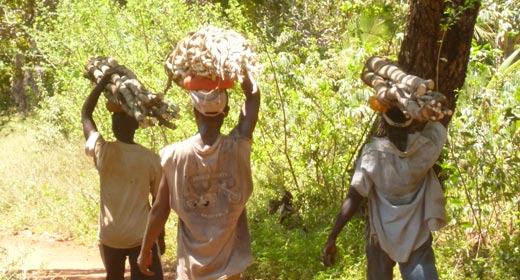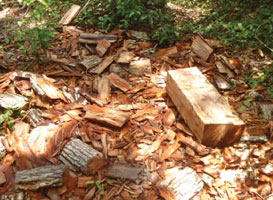
By Zach Petroni (BA '13)
Kenya's Arabuko-Sokoke Forest (ASF), the largest remnant of a hardwood forest that once spanned East Africa's coast from Somalia to southern Mozambique, is a refuge for dozens of endemic and endangered flora and fauna—the Sokoke Scops Owl, Amani Sunbird, and Golden-Rumped Elephant Shrew among them.
The 420-square-kilometer reserve, roughly the size of the city of New Orleans, is internationally recognized as a biodiversity hotspot—the highest distinction bestowed by conservationists prioritizing what remains of the world's natural heritage. An aerial view is all it takes to see why: the forest is an island of verdant green that lies in stark contrast to the drab, beige-colored backdrop of the region that surrounds it.
 |
|
Evidence of lumber harvesting in Arabuko-Sokoke |
This contrast illuminates something else, as well: Arabuko-Sokoke is an island of conservation in a much greater, human-dominated landscape where thousands of Kenya's people make their homes. Most of the people who live around the forest are subsistence farmers, "economic have-nots." With few opportunities for formal employment, informal activities—such as tapping palms for wine, ferrying charcoal to urban centers, or illegally harvesting timber and poaching wildlife from within the forest—can be the difference between destitution and survival, between survival and advancement.
For these people, the forest is a "resource sink." It helps them cope with temporary vulnerabilities like droughts and failed harvests; it helps them stave off enduring, structural challenges, like a lack of paying jobs; and it also enables a kind of nonessential opportunism humans have practiced throughout history (the same opportunism that has fueled the economic growth of the Western world).
These distinctions, though, rarely factor into the conservation equation—a key reason why conservation efforts aimed at preserving Arabuko-Sokoke's unique biodiversity have been fraught with contention.
Some progress has been made. In the past two decades, commercial logging, once allowed, has been halted, and more humane conservation practices are employed, allowing a few uses that conservationists deem less destructive, like firewood collection and butterfly harvesting. These days, there are also alternative livelihoods programs for forest-adjacent communities (such as bee-keeping and agroforesty) and a pilot initiative that grants villagers the opportunity to manage sections of the forest in partnership with conservation officials.
Unfortunately, persistent poverty, profit-seeking, and delays in joint management continue to frustrate conservation efforts. Local sources say that destruction of the forest is reaching a volume unseen in recent years.
Forest officials and conservationists may understand the ecological value of Arabuko-Sokoke, but they've mostly failed to include people in their ecological model. Thinking only of binaries—conservation versus use, forest versus farmland—they jeopardize the welfare of those who call this region home, and ultimately the forest itself.
To learn more, read William Foreman's story about Petroni's Raoul Wallenberg Fellowship experience, "Hauling charcoal, studying conservation in Kenya."
Zachary Petroni is the inaugural recipient of the Raoul Wallenberg Fellowship, established in honor of one of the University of Michigan's most heroic alumni. To learn more about Raoul Wallenberg (BA '35), visit The American Experience: Raoul Wallenberg (PBS) and The Story of Raoul Wallenberg.
Below is a formatted version of this article from State & Hill, the magazine of the Ford School. View the entire Spring 2014 State & Hill here.